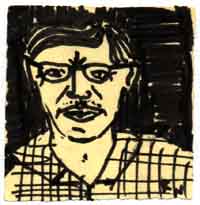IMAGINING
ROBERT is a story of two brothers, one who has suffered the horrors
and sadness of mental illness for thirty-eight years--the other, a prize-winning
novelist who has been his brother's primary caretaker through these
years. Based on the life experiences of Jay and Robert Neugeboren, IMAGINING
ROBERT is a true story--true not only for the protagonists, but for
millions of other Americans. Jay, Writer-in-Residence at the University
of Massachusetts/Amherst, published Imagining Robert: My Brother, Madness,
and Survival in 1997. The book struck a nerve with hundreds of thousands
of Americans for many reasons, including the fact that, according to
the National Institute of Mental Health, at least 17 million Americans
are affected, in their nuclear families alone, by long-term severe mental
illnesses.
IMAGINING ROBERT is one of the first films to tell what it is like for
these millions of families that cope, day by day and year by year, over
the course of a lifetime, with a condition for which, in most cases,
there is no solution. By setting Jay and Robert's story within the context
of their particular family history, we will share the anguish, the despair,
the joys, and the frustrations that Jay and Robert have experienced
in their struggles to survive, and to do more than survive.
BACKGROUND
Robert
experienced his first episode of mental illness during his freshman
year at the City College of New York -- since then he has been hospitalized
and re-hospitalized for  mental
illness (schizophrenia, manic-depression) more than fifty times. For
thirty-seven years he has lived within the mental health system, his
treatment and prognosis changing with each new doctor and each new "cure."
He has been in state hospitals, city hospitals, halfway houses, group
homes, jail cells, elite treatment centers, forensic hospitals, and,
for brief periods, in his own apartments. He has been treated with gas
inhalation, insulin coma therapy, four-point restraints, and virtually
the entire armamentaria of neuroleptic and psychotropic drugs. Through
the years he's also participated in group therapy, family therapy, multifamily
group therapy, psychoanalytically-oriented psychotherapy, art therapy,
behavioral therapy, vocational rehabilitation therapy, and milieu therapy.
Most often, though, he has had an abundance of drugs and a sad lack
of care.
mental
illness (schizophrenia, manic-depression) more than fifty times. For
thirty-seven years he has lived within the mental health system, his
treatment and prognosis changing with each new doctor and each new "cure."
He has been in state hospitals, city hospitals, halfway houses, group
homes, jail cells, elite treatment centers, forensic hospitals, and,
for brief periods, in his own apartments. He has been treated with gas
inhalation, insulin coma therapy, four-point restraints, and virtually
the entire armamentaria of neuroleptic and psychotropic drugs. Through
the years he's also participated in group therapy, family therapy, multifamily
group therapy, psychoanalytically-oriented psychotherapy, art therapy,
behavioral therapy, vocational rehabilitation therapy, and milieu therapy.
Most often, though, he has had an abundance of drugs and a sad lack
of care.
GOALS
Many films
look at mental illness, or new drugs, or experimental therapies. This
film will look at the impact these things have on one family, and how
that one family's experience has meaning for us all.
IMAGINING
ROBERT will stimulate national and international debate and discussion
about the care and treatment of individuals with serious mental illnesses,
and about the effects of severe and persistent mental illnesses on families
who must struggle with the fact of these conditions across entire lives.
We know of success stories and "star" stories--the Patty Dukes,
Kay Jamisons, Mike Wallaces, and William Styrons who suffer psychiatric crises, receive good treatment, and get well. But
most people with severe mental illness are not stars, and most do not
get well.
suffer psychiatric crises, receive good treatment, and get well. But
most people with severe mental illness are not stars, and most do not
get well.
The stigma,
shame, and secrecy that accompany mental illness invariably isolate
individuals and families, so that the stories of millions of individuals
like Jay and Robert remain, for the most part, invisible to the nation
at large. Out-of-mind usually means out-of-sight, and thus, as a nation,
we know little about the lives and needs of these people and their families.
PRODUCERS
Jay and
Robert appear in the film, along with a cast of family characters and
mental health professionals. The film was produced,directed, and filmed
by Lawrence Hott and edited by Diane Garey. Hott and Garey have received
an Emmy, the Peabody Award, two Academy Award nominations and have produced
fifteen award-winning films for national PBS broadcast.
